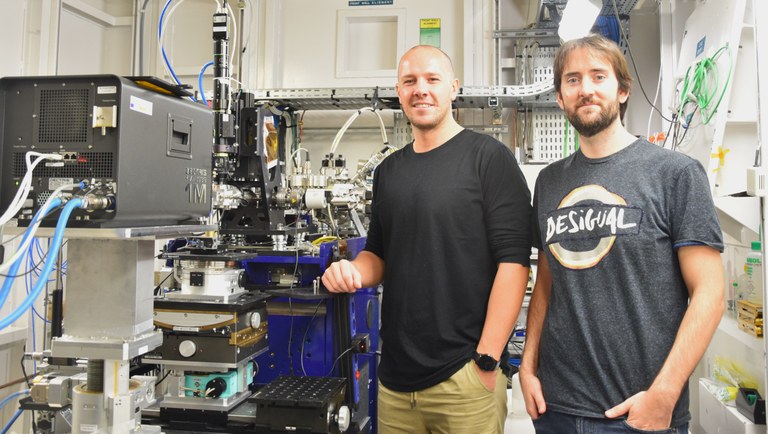Do you want to keep up to date? Subscribe to our newsletter. 1 mail every 2 months! |
 |

From left to right, Julian Steele, scientist at KU Leuven and at the University of Queensland, and Eduardo Solano, beamline scientist at NCD-SWEET.
Cerdanyola del Vallès, 4th October 2023 Silicon solar cells that are commonly used for solar electricity generation are limited in terms of efficiency — the amount of sunlight that hits a solar cell and gets converted into electricity. The current highest efficiency records for silicon-only solar cells stand around 24.5% for commercial cells and 27% in laboratory settings. These figures are considered close to the theoretical maximum of 29% for such cells, with little progress in moving this number higher in recent years. Research groups worldwide are engaged in efforts to enhance the efficiency and develop innovative materials, like metal halide perovskites, as potential alternatives to silicon.
Racing past crucial energy barrier
To overcome this efficiency limitation and further reduce the costs of solar electricity, scientists from EPFL's PV-Lab and CSEM have been exploring innovative approaches and finally demonstrated, in the article published in Science, an efficiency of 31.25% by stacking silicon and perovskite cells in a so-called tandem structure. This achievement marks the first time a low-cost technology has surpassed the 30% efficiency milestone.
Tandem solar cells offer improved utilization of solar energy by optimizing each sub-cell to capture different parts of the solar spectrum. However, a typical limitation of perovskite-on-silicon tandem cells is the recombination losses that occur at the perovskite interface with the electron selective contact. Recombination refers to the loss of photogenerated charge carriers before they can be collected and utilized to generate electricity.
To address this issue, EPFL’s and CSEM’s scientists started with a standard commercial silicon cell and incorporated an additive in the processing sequence when growing the perovskite crystal on top. This additive effectively regulated the perovskite crystallization process and passivated the perovskite top interface. Passivation involves adapting the structure and chemistry of interfaces and surfaces so that energy loss is minimized, and a maximum of the energy generated can be utilized efficiently.
A bright light for a brighter energy future
In order to deeply analyse the impact of the additive on the perovskite crystallization process, grazing incidence wide-angle x-ray scattering (GIWAXS) was performed at the ALBA Synchrotron. "GIWAXS provides detailed information about the crystallographic structure, orientation, and phase transitions within the material", explains Eduardo Solano, beamline scientist at ALBA. In particular, Solano gives support to research groups who come to ALBA for using this synchrotron light-based technique at NCD-SWEET, a flexible dynamic multipurpose beamline that can accommodate a large variety of sample environments for in situ experiments.
"This modular configuration allows us to see the whole perovskite crystallization process in real time, under a controlled crystallization conditions", explains Julian Steele, one of the authors of the article in Science and scientist at KU Leuven and at the University of Queensland. "The frequency of reports utilizing synchrotron-based GIWAXS to study metal halide perovskite thin films has exploded recently, as this technique has proven invaluable for understanding several structure-property relationships that fundamentally limit optoelectronic performance", highlights Steele.
Crossing the 30% efficiency barrier represents a major breakthrough. However, the degradation of tandem cells over time in real-world conditions remains a challenge that needs to be addressed. The long-term stability of these cells is critical for their viability as a practical and durable energy solution. Looking ahead, the focus thus shifts towards ensuring its longevity and cost-effectiveness. While multi-junction solar cells (cells made of different semiconductor materials) with even higher efficiencies exist (up to 47%), they are expensive to produce and are mostly suitable for specific applications, such as space satellites or concentrated sunlight scenarios. As the solar industry races to achieve greater efficiency, experts believe that practical limits for efficiency are likely well beyond 35%, and continued research and development funding will be essential to keep up with the escalating demand for solar power.
Reference: Xin Yu Chin, Deniz Turkay, Julian A. Steele, Saba Tabean, Santhana Eswara, Mounir Mensi, Peter Fiala, Christian M. Wolff, Adriana Paracchino, Kerem Artuk, Daniel Jacobs, Quentin Guesnay, Florent Sahli, Gaëlle Andreatta, Mathieu Boccard, Quentin Jeangros, Christophe Ballif. Interface passivation for 31.25%-efficient perovskite/silicon tandem solar cells. Science 381, 59-63 (2023). DOI: 10.1126/science.adg0091
Adapted from the original news at LIST (Luxembourg Institute of Science and Technology) and at CSEM (Centre Suisse d'Electronique et de Microtechnique).




